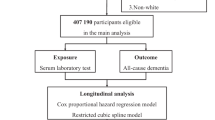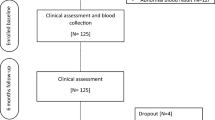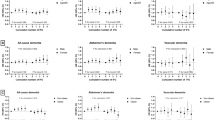Abstract
Insulin-like growth factor 1 (IGF-1) influences cell proliferation and survival. In the extracellular environment, IGF-1 circulates bound to proteins (IGF-binding proteins; IGFBP), some of which have physiological effects that seem independent of IGF-1, including the brain (for example, IGFBP-3). We completed a systematic review of the association between dementia and IGF-1 and IGFBP-3, and a cross-sectional and longitudinal study designed to investigate if lower plasma concentration of these proteins increased the risk of prevalent and incident dementia. A total of 3967 men aged 71–89 years joined the study, of whom 535 (13.5%) showed evidence of prevalent cognitive impairment. The plasma concentrations of IGF-1 and IGFBP-3 were similar for men with and without cognitive impairment. The 3432 men free of cognitive impairment were then followed for up to 13 years. During this time 571 (16.6%) developed dementia. The plasma concentration of IGF-1 had no association with incident dementia. The doubling of the plasma concentration of IGFBP-3 decreased the hazard ratio of dementia by 23% (95% confidence interval=5–37%). The results were not affected by age, body mass index and history of smoking, diabetes, hypertension, coronary heart disease or stroke. If these findings are confirmed by others, the plasma concentration of IGFBP-3 could be used to improve the accuracy of predictive models of dementia and as a potential new factor to assist in the development of prevention and treatment strategies.
This is a preview of subscription content, access via your institution
Access options
Subscribe to this journal
Receive 12 print issues and online access
$259.00 per year
only $21.58 per issue
Buy this article
- Purchase on Springer Link
- Instant access to full article PDF
Prices may be subject to local taxes which are calculated during checkout

Similar content being viewed by others
References
Clemmons DR. Clinical utility of measurements of insulin-like growth factor 1. Nat Clin Pract Endocrinol Metab 2006; 2: 436–446.
Baxter RC. IGF binding proteins in cancer: mechanistic and clinical insights. Nat Rev Cancer 2014; 14: 329–341.
Baxter RC. Insulin-like growth factor binding protein-3 (IGFBP-3): novel ligands mediate unexpected functions. J Cell Commun Signal 2013; 7: 179–189.
Yeap BB, Chubb SA, McCaul KA, Ho KK, Hankey GJ, Norman PE et al. Associations of IGF1 and IGFBPs 1 and 3 with all-cause and cardiovascular mortality in older men: the Health In Men Study. Eur J Endocrinol 2011; 164: 715–723.
Watanabe K, Uemura K, Asada M, Maesako M, Akiyama H, Shimohama S et al. The participation of insulin-like growth factor-binding protein 3 released by astrocytes in the pathology of Alzheimer’s disease. Mol Brain 2015; 8: 82.
Hu X, Yang Y, Gong D. Circulating insulin-like growth factor 1 and insulin-like growth factor binding protein-3 level in Alzheimer’s disease: a meta-analysis. Neurol Sci 2016; 37: 1671–1677.
Green CJ, Holly JM, Bayer A, Fish M, Ebrahim S, Gallacher J et al. The role of IGF-I, IGF-II, and IGFBP-3 in male cognitive aging and dementia risk: the Caerphilly Prospective Study. J Alzheimers Dis 2014; 41: 867–875.
Holman CD, Bass AJ, Rosman DL, Smith MB, Semmens JB, Glasson EJ et al. A decade of data linkage in Western Australia: strategic design, applications and benefits of the WA data linkage system. Aust Health Rev 2008; 32: 766–777.
Norman PE, Flicker L, Almeida OP, Hankey GJ, Hyde Z, Jamrozik K. Cohort Profile: The Health In Men Study (HIMS). Int J Epidemiol 2009; 38: 48–52.
Crum RM, Anthony JC, Bassett SS, Folstein MF. Population-based norms for the Mini-Mental State Examination by age and educational level. JAMA 1993; 269: 2386–2391.
McCaul KA, Almeida OP, Norman PE, Yeap BB, Hankey GJ, Golledge J et al. How many older people are frail? Using multiple imputation to investigate frailty in the population. J Am Med Dir Assoc 2015; 16: e431–e437.
Prince M, Albanese E, Guerchet M, Prina M. World Alzheimer Report 2014—Dementia and Risk Reduction: An Analysis of Protective and Modifiable Factors. Alzheimer’s Disease International: London, UK, 2014.
ABS. 3412.0—Migration, Australia, 2013-14. Australian Bureau of Statistics: Canberra, ACT, Australia 2015.
Preen DB, Holman CD, Lawrence DM, Baynham NJ, Semmens JB. Hospital chart review provided more accurate comorbidity information than data from a general practitioner survey or an administrative database. J Clin Epidemiol 2004; 57: 1295–1304.
Matthews FE, Stephan BC, Robinson L, Jagger C, Barnes LE, Arthur A et al. A two decade dementia incidence comparison from the Cognitive Function and Ageing Studies I and II. Nat Commun 2016; 7: 11398.
Duron E, Funalot B, Brunel N, Coste J, Quinquis L, Viollet C et al. Insulin-like growth factor-I and insulin-like growth factor binding protein-3 in Alzheimer’s disease. J Clin Endocrinol Metab 2012; 97: 4673–4681.
Hertze J, Nagga K, Minthon L, Hansson O. Changes in cerebrospinal fluid and blood plasma levels of IGF-II and its binding proteins in Alzheimer’s disease: an observational study. BMC Neurol 2014; 14: 64.
Murialdo G, Barreca A, Nobili F, Rollero A, Timossi G, Gianelli MV et al. Relationships between cortisol, dehydroepiandrosterone sulphate and insulin-like growth factor-I system in dementia. J Endocrinol Invest 2001; 24: 139–146.
Tei E, Yamamoto H, Watanabe T, Miyazaki A, Nakadate T, Kato N et al. Use of serum insulin-like growth factor-I levels to predict psychiatric non-response to donepezil in patients with Alzheimer’s disease. Growth Horm IGF Res 2008; 18: 47–54.
Vardy ER, Rice PJ, Bowie PC, Holmes JD, Grant PJ, Hooper NM. Increased circulating insulin-like growth factor-1 in late-onset Alzheimer’s disease. J Alzheimers Dis 2007; 12: 285–290.
Johansson P, Aberg D, Johansson JO, Mattsson N, Hansson O, Ahren B et al. Serum but not cerebrospinal fluid levels of insulin-like growth factor-I (IGF-I) and IGF-binding protein-3 (IGFBP-3) are increased in Alzheimer’s disease. Psychoneuroendocrinology 2013; 38: 1729–1737.
Dai H, Goto YI, Itoh M. Insulin-like growth factor binding protein-3 deficiency leads to behavior impairment with monoaminergic and synaptic dysfunction. Am J Pathol 2017; 187: 390–400.
Acknowledgments
This work was funded through competitive project grants from the National Health and Medical Research Council of Australia (NHMRC), numbers 279408, 379600, 403963, 513823, 540403, 540504, 540405, 634492, 1021416, 1045710 and 1060557. The sponsors had no role in the design and conduct of the study; collection, management, analysis, and interpretation of the data; or preparation, review, or approval of the manuscript. We thank research staff and study participants for their generous contribution.
Author information
Authors and Affiliations
Corresponding author
Ethics declarations
Conflict of Interest
The authors declare no conflict of interest.
Electronic supplementary material
Rights and permissions
About this article
Cite this article
Almeida, O.P., Hankey, G.J., Yeap, B.B. et al. Risk of prevalent and incident dementia associated with insulin-like growth factor and insulin-like growth factor-binding protein 3. Mol Psychiatry 23, 1825–1829 (2018). https://doi.org/10.1038/mp.2017.152
Received:
Revised:
Accepted:
Published:
Issue Date:
DOI: https://doi.org/10.1038/mp.2017.152



